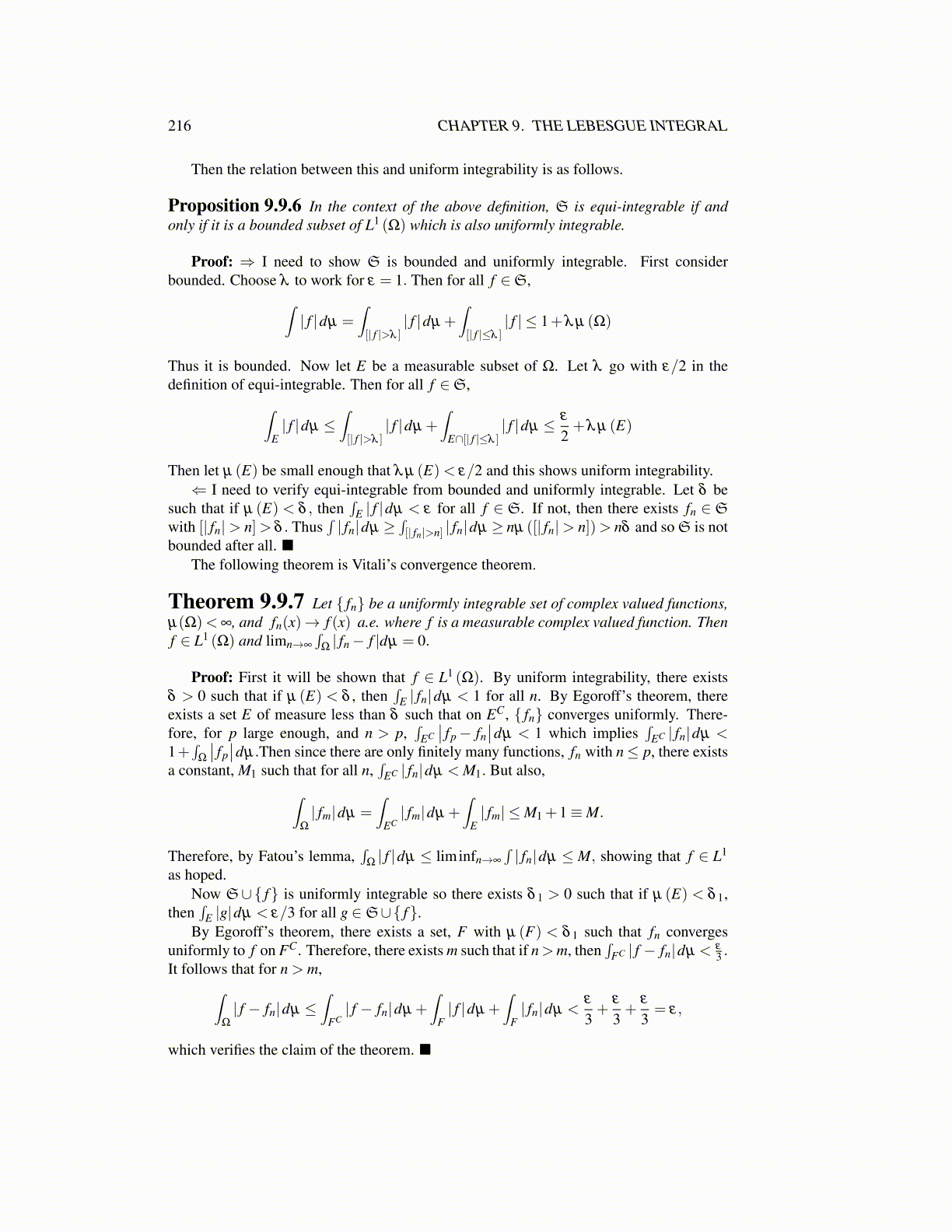
216 CHAPTER 9. THE LEBESGUE INTEGRAL
Then the relation between this and uniform integrability is as follows.
Proposition 9.9.6 In the context of the above definition, S is equi-integrable if andonly if it is a bounded subset of L1 (Ω) which is also uniformly integrable.
Proof: ⇒ I need to show S is bounded and uniformly integrable. First considerbounded. Choose λ to work for ε = 1. Then for all f ∈S,∫
| f |dµ =∫[| f |>λ ]
| f |dµ +∫[| f |≤λ ]
| f | ≤ 1+λ µ (Ω)
Thus it is bounded. Now let E be a measurable subset of Ω. Let λ go with ε/2 in thedefinition of equi-integrable. Then for all f ∈S,∫
E| f |dµ ≤
∫[| f |>λ ]
| f |dµ +∫
E∩[| f |≤λ ]| f |dµ ≤ ε
2+λ µ (E)
Then let µ (E) be small enough that λ µ (E)< ε/2 and this shows uniform integrability.⇐ I need to verify equi-integrable from bounded and uniformly integrable. Let δ be
such that if µ (E) < δ , then∫
E | f |dµ < ε for all f ∈ S. If not, then there exists fn ∈ Swith [| fn|> n]> δ . Thus
∫| fn|dµ ≥
∫[| fn|>n] | fn|dµ ≥ nµ ([| fn|> n])> nδ and so S is not
bounded after all. ■The following theorem is Vitali’s convergence theorem.
Theorem 9.9.7 Let { fn} be a uniformly integrable set of complex valued functions,µ(Ω)< ∞, and fn(x)→ f (x) a.e. where f is a measurable complex valued function. Thenf ∈ L1 (Ω) and limn→∞
∫Ω| fn− f |dµ = 0.
Proof: First it will be shown that f ∈ L1 (Ω). By uniform integrability, there existsδ > 0 such that if µ (E) < δ , then
∫E | fn|dµ < 1 for all n. By Egoroff’s theorem, there
exists a set E of measure less than δ such that on EC, { fn} converges uniformly. There-fore, for p large enough, and n > p,
∫EC
∣∣ fp− fn∣∣dµ < 1 which implies
∫EC | fn|dµ <
1+∫
Ω
∣∣ fp∣∣dµ.Then since there are only finitely many functions, fn with n≤ p, there exists
a constant, M1 such that for all n,∫
EC | fn|dµ < M1. But also,∫Ω
| fm|dµ =∫
EC| fm|dµ +
∫E| fm| ≤M1 +1≡M.
Therefore, by Fatou’s lemma,∫
Ω| f |dµ ≤ liminfn→∞
∫| fn|dµ ≤ M, showing that f ∈ L1
as hoped.Now S∪{ f} is uniformly integrable so there exists δ 1 > 0 such that if µ (E) < δ 1,
then∫
E |g|dµ < ε/3 for all g ∈ S∪{ f}.By Egoroff’s theorem, there exists a set, F with µ (F) < δ 1 such that fn converges
uniformly to f on FC. Therefore, there exists m such that if n>m, then∫
FC | f − fn|dµ < ε
3 .It follows that for n > m,∫
Ω
| f − fn|dµ ≤∫
FC| f − fn|dµ +
∫F| f |dµ +
∫F| fn|dµ <
ε
3+
ε
3+
ε
3= ε,
which verifies the claim of the theorem. ■